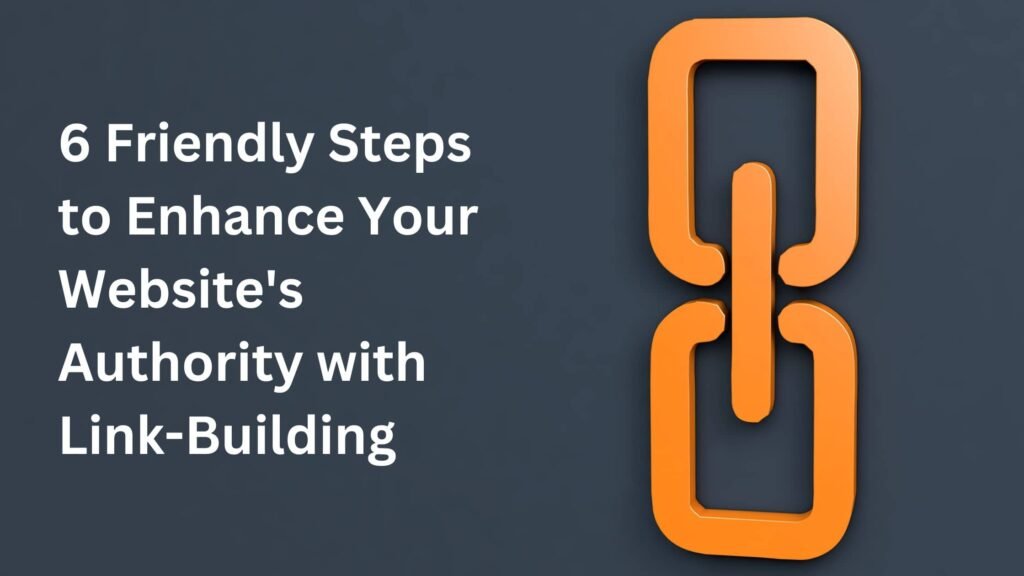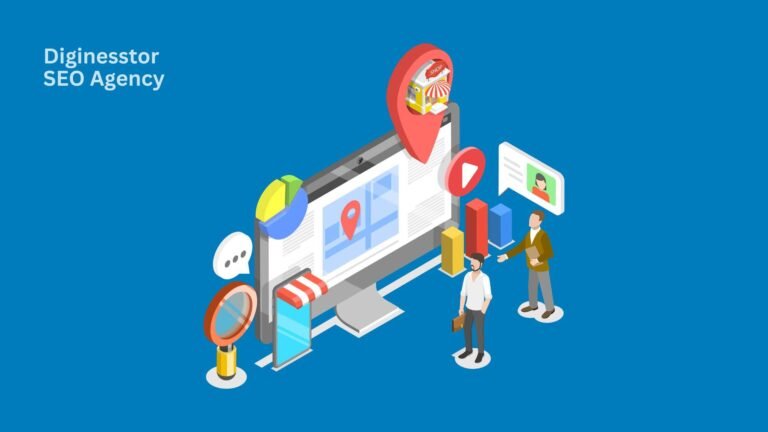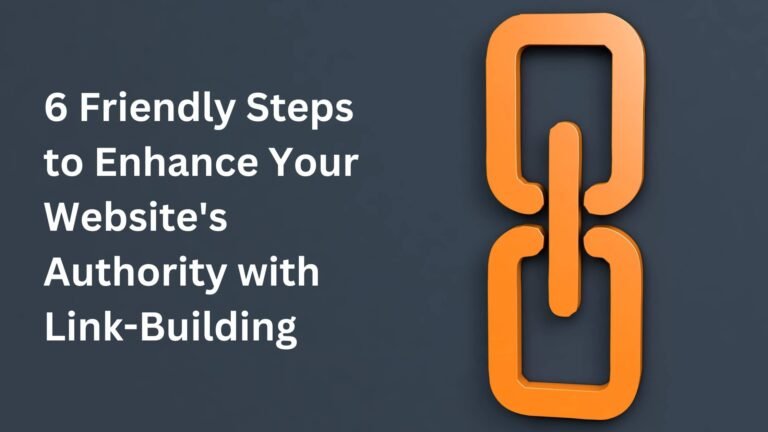Link-Building Uncovered: 6 Essential Steps for Website Authority and Ranking Success

In today’s digital age, a solid online presence is essential for businesses and individuals. And one of the most effective ways to boost your online presence is through link-building. Link-building is acquiring backlinks from other websites to your website. Backlinks are important because they signal to search engines that other websites consider your content to be valuable and authoritative. As a result, it can help improve your search engine rankings and drive more traffic to your website. However, link-building is not a one-size-fits-all strategy. Depending on your goals, industry, and target audience, you can take many different tactics and approaches. In this blog, we’ll explore the various components of link-building, from defining your goals to conducting link prospecting and outreach. We’ll also provide tips and best practices to help you create a successful link-building campaign that drives results.
Here are some key components or tasks to implement link-building:

1. Define your link-building goals
Before starting your link-building campaign, you must define your goals and what you want to achieve through link-building. It could include improving search engine rankings, increasing website traffic, or building brand awareness. It will help you determine the type of links you need to acquire and the tactics you need to use. Also, the metrics you need to track to measure the success of your efforts.
Below are some important considerations when defining your link-building goals:
- Improve search engine rankings: One of the most common link-building goals is to improve search engine rankings. The more high-quality, relevant backlinks your website has, the more likely it is to rank higher in search engines. Set specific goals for the number and quality of backlinks you want to acquire.
- Increase website traffic: Another goal of link-building is to drive more traffic to your website. When you acquire backlinks from authoritative and relevant websites, you see an increase in referral traffic to your site.
- Build brand awareness: Building links from high-profile websites in your industry can help increase your brand’s visibility and awareness. It can lead to more brand mentions, social shares, and even new business opportunities.
- Generate leads and sales: If your website is an e-commerce site or offers services online, you should focus on acquiring links likely to generate leads and sales. It could include links from review sites, industry directories, or other websites that cater to your target audience.
- Establish your website as an authority: If you want to establish your website as an authority in your industry, you should acquire links from authoritative websites. It will help improve your search engine rankings. Also, help build your reputation as a trusted source of information.
Set specific, measurable goals for your link-building campaign and track your progress regularly. You will determine what’s working and what’s not so that you can adjust your strategy accordingly.

2. Identify your target audience
Determine your target audience and what websites or online communities they frequent. Next, you should identify potential link opportunities.
Identifying your target audience is a crucial step in any link-building campaign. It will help you determine the websites and online communities most likely interested in linking to your content.
- Determine your ideal customer: Whom are your products or services aimed at? What are their interests, behaviours, and preferences? Answering these questions will help you identify the websites and communities your target audience will likely frequent.
- Conduct keyword research: Use keyword research tools to identify the search terms your target audience uses to find information related to your industry. It helps you discover websites and online communities relevant to your target audience.
- Analyze your existing audience: Look at your current website traffic and social media followers to identify demographic information like age, gender, location, and interests. It can give you insight into the type of websites and communities your target audience will likely engage with.
- Identify industry influencers: Research industry influencers and thought leaders in your niche to see where they publish content and engage with their audience. It can help you identify potential link opportunities and build relationships with influential websites.
- Monitor social media: Monitor social media channels like Twitter and Linkedin to see what your target audience is talking about and what websites they share. Discovering relevant websites and communities likely to be interested in your content would be best.
Identifying your target audience is an ongoing process, and staying up-to-date with changes in industry and audience behaviour is essential. By focusing on the websites and communities, you can increase the likelihood of acquiring high-quality backlinks that drive results.

3. Conduct link prospecting
Use tools like Moz or SEMrush to identify websites relevant to the industry and interested in linking to your content. You can also find potential link opportunities through competitor research, backlink analysis, and social media research.
Conducting link prospecting is a crucial component of any successful link-building campaign. It involves identifying websites and online communities relevant to your industry that may be interested in linking to your content.
Here are some important considerations when conducting link prospecting:
- Identify relevant websites: Use search engines, industry directories, and social media channels to identify websites relevant to your industry and target audience. Look for websites that publish content related to your niche and that cover related topics that may interest your target audience.
- Analyze domain authority: Use tools like Moz, Ahrefs, or SEMrush to analyze the domain authority of potential link prospects. Look for websites with high domain authority scores, as these are more likely to impact your search engine rankings positively.
- Analyze backlink profiles: Analyze the backlink profiles of potential link prospects to see what websites link to them. Look for websites with a diverse range of high-quality backlinks, as these are more likely to be viewed positively by search engines.
- Look for broken link opportunities: Use tools like Broken Link Checker or Ahrefs to identify broken links on relevant websites. Reach out to the website owner or editor and suggest linking to your content to replace the broken link.
- Consider guest posting opportunities: Look for websites that accept guest posts in your niche. Guest posting is a great way to build relationships with other websites and acquire high-quality backlinks to your website.
Link prospecting is an ongoing process, and it’s essential to identify and evaluate new prospects regularly. In addition, focusing on high-quality, relevant websites and online communities can increase the likelihood of acquiring backlinks that drive results.

4. Create linkable assets
Develop high-quality, informative, and engaging content that people will want to link to. It could include blog posts, infographics, whitepapers, case studies, or interactive tools.
Here are some important considerations when creating linkable assets:
- Determine your audience’s interests: Consider what topics your target audience is interested in and what content they will likely engage with. It could be anything from how-to guides and tutorials to infographics, videos, or research reports.
- Conduct keyword research: Use keyword research tools like Google Keyword Planner, Ahrefs, or Moz to identify search terms and phrases related to your industry that your target audience is likely to be searching for. Use these insights to inform the topics and content of your linkable assets.
- Create high-quality content: Ensure your linkable assets are well-written, informative, and visually appealing. Use high-quality images, videos, or graphics to make your content more engaging and memorable.
- Provide value to your audience: Ensure that your linkable assets provide real value to your target audience. It could be anything from answering a common question or solving a problem to sharing expert insights or data-driven research.
- Promote your content: Once your linkable assets are created, it’s important to promote them through social media, email newsletters, and other digital channels. Ir can increase the visibility of your content and attract links from other websites.
It’s important to regularly create new content to attract links and engage with your audience. Creating high-quality, informative content that provides real value to your target audience can increase the likelihood of acquiring backlinks that drive results.

5. Outreach and relationship building
Reach out to website owners, editors, and bloggers to introduce yourself, share your content, and build relationships. You can do this through email, social media, or direct messaging.
Outreach and relationship-building are essential components of any successful link-building campaign. These involve reaching out to relevant websites and online communities to establish relationships and earn backlinks to your website.
Here are some important considerations when conducting outreach and relationship building:
- Personalize your outreach: When reaching out to website owners or editors, it’s essential to personalize your outreach efforts. Start by researching the website or online community and identifying the person responsible for the content or website management. Use their name and mention specific details about their website or content to show that you’ve done your homework and are genuinely interested in working with them.
- Build relationships: When conducting outreach, build relationships with other website owners and editors. Take the time to engage with their content, share their posts on social media, and offer to collaborate on future projects. This helps establish trust and credibility, making it more likely that they will link to your content in the future.
- Provide value: When reaching out to potential link prospects, it’s important to provide real value. It can be anything from sharing your expertise or offering guest content for their website to sharing exclusive data or insights they can’t find elsewhere.
- Follow-up: After conducting outreach, follow up with potential link prospects to keep the conversation going. Send a friendly reminder email or follow up on social media to keep the lines of communication open and show that you’re serious about building a relationship.
- Be persistent: Link-building can be time-consuming, and it’s essential to be persistent in your outreach efforts. Don’t be discouraged if you don’t receive a response right away, and don’t be afraid to follow up multiple times if you think there’s a potential opportunity for collaboration.
Outreach and relationship building are ongoing processes, and it’s crucial to identify and evaluate new link prospects regularly. By focusing on building solid relationships with other website owners and editors, you can increase the likelihood of acquiring high-quality backlinks that drive results.

6. Monitor and measure your results
Keep track of your backlink profile, search engine rankings, and website traffic to see how your link-building efforts are impacting your online presence.
Monitoring and measuring the results of your link-building efforts is an essential part of the process. Here’s why:
- Evaluate the effectiveness of your strategy: By tracking your link-building results, you can evaluate the effectiveness of your strategy and identify areas for improvement. You can track metrics such as the number of backlinks acquired, the quality of those backlinks, and the impact on your search engine rankings.
- Make data-driven decisions: Data-driven decision-making is essential in link-building. By monitoring your results, you can decide which strategies to continue using and which to modify or abandon.
- Identify new opportunities: Monitoring your results can also help you identify new link-building opportunities you may have overlooked. For example, you notice that a particular type of content is generating a high number of backlinks. In that case, you should create more content of that type.
- Build relationships: Monitoring your results can also help you build relationships with website owners and editors. You can establish a rapport and increase the likelihood of future collaborations by keeping track of your interactions and following up with website owners and editors.
To monitor and measure your link-building results, you can use various tools such as Ahrefs, Moz, Google Analytics, and SEMrush. These tools can help you track your backlink profile, search engine rankings, and traffic metrics, providing valuable insights into the effectiveness of your link-building strategy. By regularly monitoring and measuring your results, you can ensure that your link-building efforts are driving results and positively impacting your website’s search engine visibility and traffic.
In the end, link-building is critical to any successful digital marketing strategy. Acquiring high-quality backlinks from authoritative websites can improve your search engine visibility, drive traffic to your website, and establish your brand as a thought leader in your industry or niche.
It’s essential to define your goals, identify your target audience, conduct link prospecting, create linkable assets, outreach and build relationships and monitor and measure your results. By following these steps and using the right tools and techniques, you can acquire high-quality backlinks that drive actual results for your website.
Just bear in mind that link-building is a long-term process that requires patience, persistence, and a willingness to adapt and evolve. By staying up-to-date with the latest trends and best practices in link-building, you can stay ahead of the competition and achieve your digital marketing goals.












1 Comment